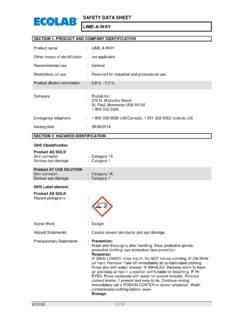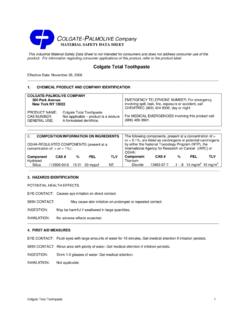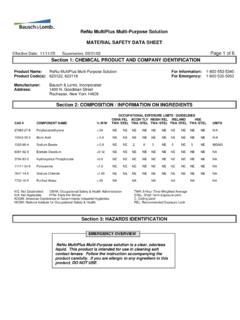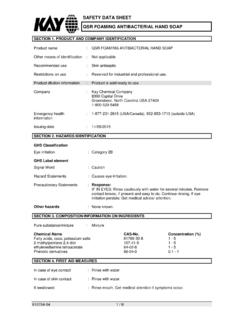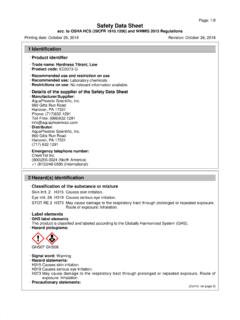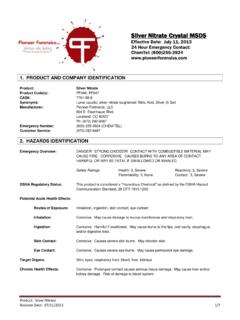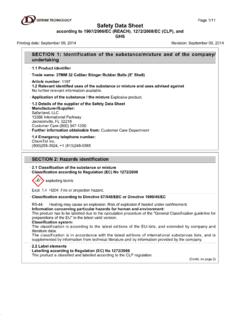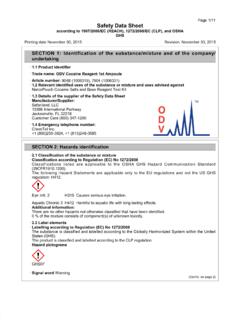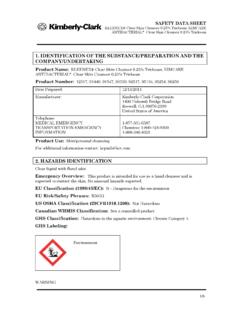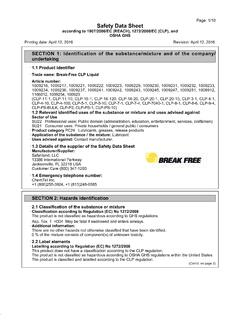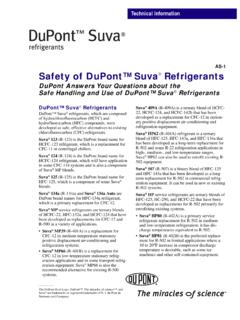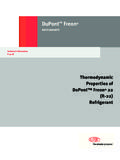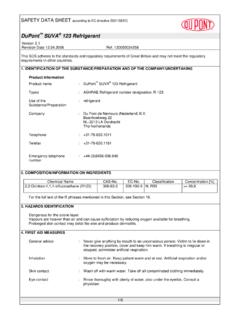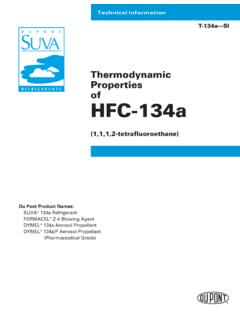Transcription of Material Safety Data Sheet - sds.chemtel.net
1 Material Safety data Sheet dupont DYMEL 134a propellant Version Revision Date 01/23/2012 Ref. 130000000343 1 / 10 This SDS adheres to the standards and regulatory requirements of the United States and may not meet the regulatory requirements in other countries. SECTION 1. PRODUCT AND COMPANY IDENTIFICATION Product name : dupont DYMEL 134a propellant Tradename/Synonym : HFA- 134a HFC- 134a MSDS Number : 130000000343 Product Use : Propellant Manufacturer : dupont 1007 Market Street Wilmington, DE 19898 Product Information : 1-800-441-7515 (outside the 1-302-774-1000) Medical Emergency : 1-800-441-3637 (outside the 1-302-774-1139) Transport Emergency : CHEMTREC.
2 1-800-424-9300 (outside the 1-703-527-3887) SECTION 2. HAZARDS IDENTIFICATION Emergency Overview Rapid evaporation of the liquid may cause frostbite. Potential Health Effects Skin 1,1,1,2-Tetrafluoroethane : Contact with liquid or refrigerated gas can cause cold burns and frostbite. May cause skin irritation. May cause: Discomfort, itching, redness, or swelling.
3 Eyes 1,1,1,2-Tetrafluoroethane : Contact with liquid or refrigerated gas can cause cold burns and frostbite. May cause eye irritation. May cause: tearing, Redness, Discomfort. Inhalation Material Safety data Sheet dupont DYMEL 134a propellant Version Revision Date 01/23/2012 Ref. 130000000343 2 / 10 1,1,1,2-Tetrafluoroethane : Misuse or intentional inhalation abuse may cause death without warning symptoms, due to cardiac effects. Other symptoms potentially related to misuse or inhalation abuse are: Anaesthetic effects, Light-headedness, dizziness, confusion, incoordination, drowsiness, or unconsciousness, irregular heartbeat with a strange sensation in the chest, heart thumping, apprehension, feeling of fainting, dizziness or weakness.
4 Vapours are heavier than air and can cause suffocation by reducing oxygen available for breathing. Carcinogenicity None of the components present in this Material at concentrations equal to or greater than are listed by IARC, NTP, or OSHA, as a carcinogen. SECTION 3. COMPOSITION/INFORMATION ON INGREDIENTS Component CAS-No. Concentration 1,1,1,2-Tetrafluoroethane 811-97-2 100 % SECTION 4.
5 FIRST AID MEASURES Skin contact : In case of contact, immediately flush skin with plenty of water for at least 15 minutes. Take off all contaminated clothing immediately. Consult a physician. Wash contaminated clothing before re-use. Treat for frostbite if necessary by gently warming affected area. Eye contact : In case of contact, immediately flush eyes with plenty of water for at least 15 minutes. Consult a physician if necessary. Inhalation : Remove from exposure, lie down. Move to fresh air. Keep patient warm and at rest. Artificial respiration and/or oxygen may be necessary.
6 Consult a physician. Ingestion : Is not considered a potential route of exposure. Material Safety data Sheet dupont DYMEL 134a propellant Version Revision Date 01/23/2012 Ref. 130000000343 3 / 10 General advice : Never give anything by mouth to an unconscious person. When symptoms persist or in all cases of doubt seek medical advice. Notes to physician : Because of possible disturbances of cardiac rhythm, catecholamine drugs, such as epinephrine, that may be used in situations of emergency life support should be used with special caution.
7 SECTION 5. FIREFIGHTING MEASURES Flammable Properties Flash point : does not flash Ignition temperature : > 743 C (> 1,369 F) at 1,013 hPa Lower explosion limit : Method : None per ASTM E681 Upper explosion limit : Method : None per ASTM E681 Fire and Explosion Hazard : Hazardous thermal decomposition products: Carbon oxides Hydrogen fluoride Carbonyl fluoride Material Safety data Sheet dupont DYMEL 134a propellant Version Revision Date 01/23/2012 Ref.
8 130000000343 4 / 10 Cylinders are equipped with pressure and temperature relief devices, but may still rupture under fire conditions. Decomposition may occur. Contact of welding or soldering torch flame with high concentrations of refrigerant can result in visible changes in the size and colour of the torch flame. This flame effect will only occur in concentrations of product well above the recommended exposure limit. Therefore stop all work and ventilate to disperse refrigerant vapors from the work area before using any open flames. This substance is not flammable in air at temperatures up to 100 deg.
9 C (212 deg. F) at atmospheric pressure. However, mixtures of this substance with high concentrations of air at elevated pressure and/or temperature can become combustible in the presence of an ignition source. This substance can also become combustible in an oxygen enriched environment (oxygen concentrations greater than that in air). Whether a mixture containing this substance and air, or this substance in an oxygen enriched atmosphere become combustible depends on the inter-relationship of 1) the temperature 2) the pressure, and 3) the proportion of oxygen in the mixture.
10 In general, this substance should not be allowed to exist with air above atmospheric pressure or at high temperatures; or in an oxygen enriched environment. For example this substance should NOT be mixed with air under pressure for leak testing or other purposes. Experimental data have also been reported which indicate combustibility of this substance in the presence of certain concentrations of chlorine. Suitable extinguishing media : Use extinguishing measures that are appropriate to local circumstances and the surrounding environment. Firefighting Instructions : In the event of fire, wear self-contained breathing apparatus.
